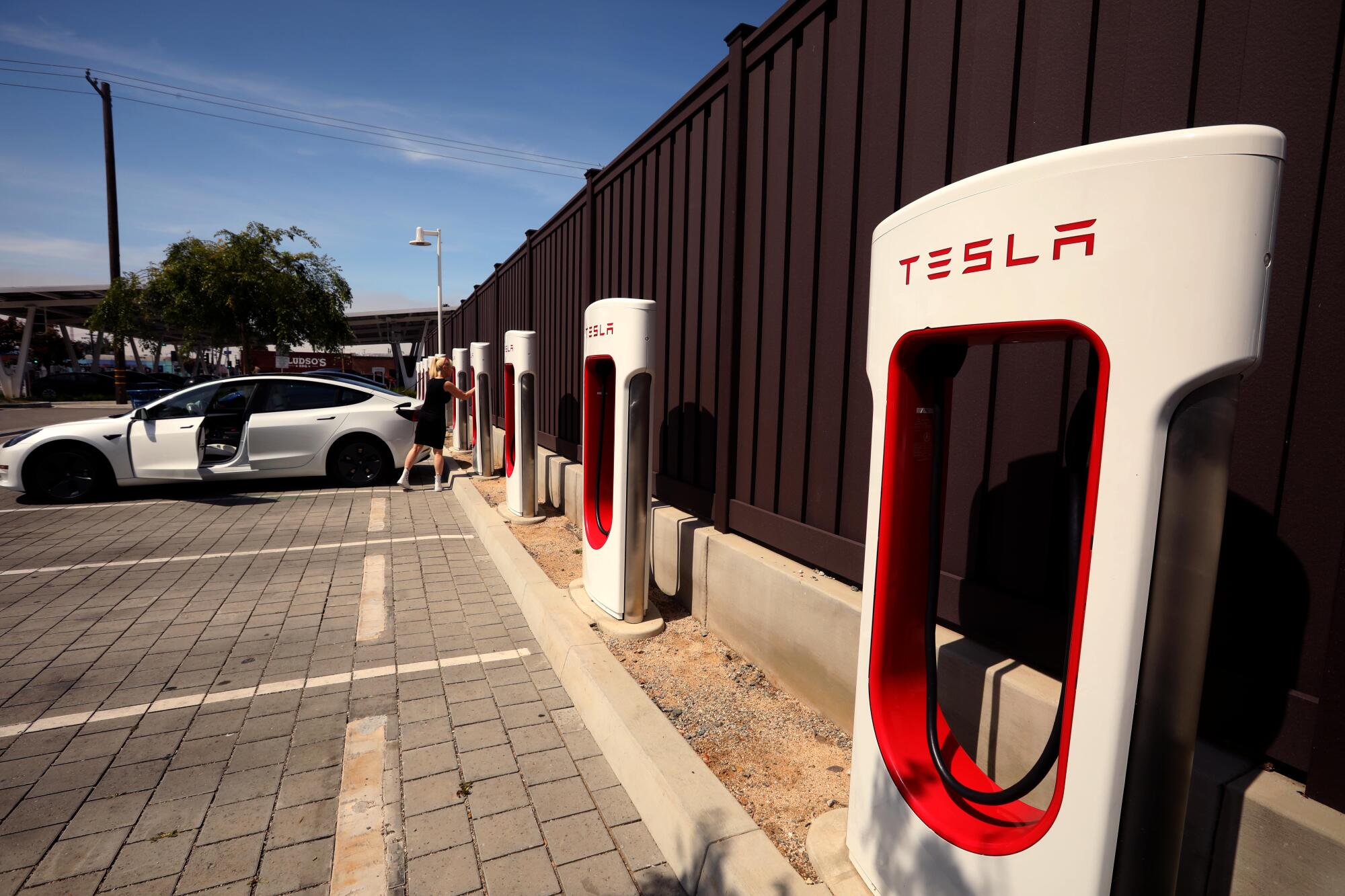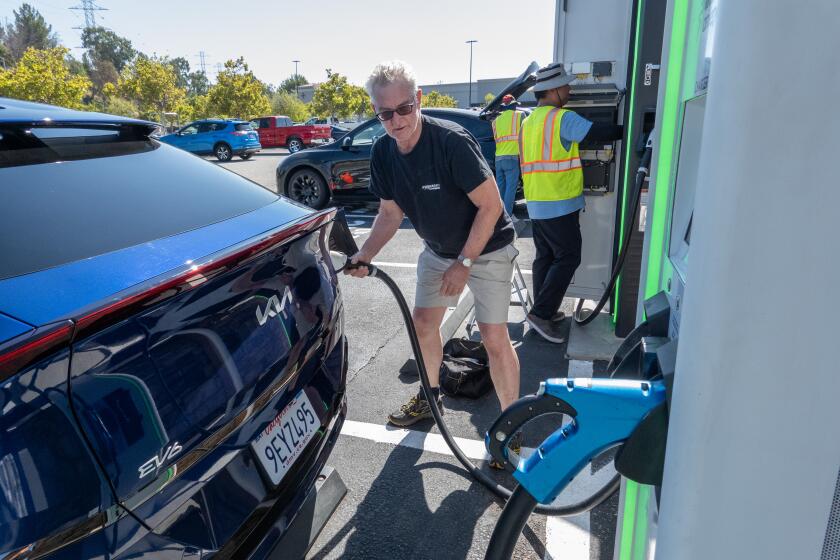
- Share via
If you visited Elon Musk’s X on Saturday and clicked on Gov. Gavin Newsom’s press office account, you could watch him pull up to a Tesla charging station, step out of an electric Ford Mustang Mach-E, and announce that Tesla Superchargers were now open to non-Tesla EVs.
It’s a questionable assertion. Owners of electric Fords, Chevys, BMWs, Mercedes-Benzes, Lucids, Nissans, Rivians and the rest can’t count on it just yet.
Aggressive and impactful reporting on climate change, the environment, health and science.
Two days after Newsom’s video, on Monday, news broke that the Tesla Supercharger network was in disarray. Musk, according to multiple media reports and social media postings, had fired or laid off his entire Supercharger team, including its senior director, Rebecca Tinucci.
A source, who declined to be identified for fear of retribution by Musk, told The Times: “They did not fire the entire Supercharger team. They mostly fired site acquisition, project management, marketing and some other things.”
Whatever the damage, Musk issued no denials. But he did post on X that Tesla plans to slow the growth of new Supercharger stations and focus on the stations it already has.
Meanwhile on Monday, sales numbers for electric vehicles in California were released, and they were grim, especially for Tesla, whose California new registrations declined 7.8% in the first quarter of the year, following a 9.8% drop the previous quarter.
Sales for the overall California EV market did grow in the first quarter — by 555 cars. The rise to 90,296 cars and light trucks, from 89,741 was under 1%, a hair’s breadth from flat, according to the California New Car Dealers Assn. EV market share was practically flat too, declining slightly from 21.2% of all new vehicles sold in last year’s fourth quarter to 20.9% for the first quarter this year.
The women who started ChargerHelp are driven to succeed and to train a workforce of people who are often overlooked. They’re also addressing a major issue with EV charging in California: reliability.
It adds up to bad news for EV proponents and for Newsom, who in 2020 mandated that all new car sales by 2035 must be what the state calls zero-emission vehicles. (Plug-in hybrid cars burn fossil fuels and thus produce emissions, but because they also can run solely on batteries, California includes them in its definition. As many as 20% of new cars sold in 2035 can be plug-in hybrids.)
Under the mandate, automakers will have to sell such cars, but customers won’t have to buy them. If flat EV growth becomes a trend and not an aberration, that could undermine a key pillar in the state’s plan for a cleaner climate.
“Everything from interest rates to inflation to increased awareness of electric vehicle costs and challenges has negatively impacted EV demand,” said Karl Brauer, industry analyst at iSeeCars.com. “Even Tesla, the brand long seen as a shining example of how every automaker should approach personal transportation, now looks very much like a traditional automaker, with shrinking market share, stalled sales, falling profits, and massive layoffs.”
One reason that potential EV buyers give for sticking with gasoline: Public chargers subsidized by the state and federal government are too few and too unreliable. Tesla chargers are widely considered more dependable. They were built with money brought in by the sky-high value of Tesla’s stock. Early last year, Tesla agreed to open up its charger network in return for federal subsidies to help pay for Tesla’s planned but now diminished charger expansion.
It’s unclear why the governor posted his video when he did. Tesla itself made no recent announcement about non-Tesla charger access. The company began opening up some stations for other brands in California and other states more than a year ago, in March 2023. The Times asked a Newsom spokesperson what actual news was announced but has yet to hear back.
Whether intended or not, the announcement created some media misunderstanding. Erroneous headlines — such as “Tesla superchargers in California now available for all electric vehicles” — began to appear.
Here’s what Newsom said: “Today we’re announcing Tesla is opening up its charging network to additional models of electric vehicles. This is all in an effort to build out the infrastructure in the state of California that currently totals 105,000 electric vehicle chargers for public use and about 10,000 of these supercharging stations.”
No new additional models had been added. A quick read could lead one to believe all Tesla stations are now available to EV drivers who don’t drive Teslas. But the actual number is far less than that. Tesla knows how many, but the company doesn’t respond to media inquiries.
The state itself doesn’t know.
“We don’t have specific numbers on how many are open to other drivers at this time,” said Lindsay Buckley at the California Energy Commission, the state agency in charge of electric vehicle infrastructure. “I understand the rollout will be gradual. Certain chargers are now open to Ford and Rivian drivers. The plan is to open to GM, Polestar and Volvo soon.”
Tesla divides it chargers into three types. One is for Tesla drivers only. Another is for EV drivers whose brands have been approved by Tesla. A third, severely limited in number at present, can handle nearly every EV with a built-in adapter called a Magic Dock that allows a Tesla charger plug to fit a non-Tesla EV.
A look at a Supercharger location map on Tesla’s website shows that sites open to other makes remain the minority. In the Palm Springs-Coachella area, there are five Tesla stations. Two of them will accept Fords or Rivians. There are no Magic Docks.
Between Culver City and Santa Monica lie six Tesla stations. Only two are open to Ford and Rivian. No Magic Docks.
California electric vehicle sales dropped significantly in the last half of 2023, raising questions about the state’s ability to phase out gas-powered cars.
According to Tesla’s map, there are three Magic Dock stations in all of California — two near Sacramento, and one in Silicon Valley.
Why the incompatibility? The auto industry developed a charger-plug standard that Tesla didn’t follow. Tesla’s version is smaller, lighter and easier to handle. Some other brands have created snap-on adapters to give or sell to their customers for Supercharger access. Several, including Ford, have announced that future EVs will be built to accept Tesla plugs without a need for adapters.
A Ford spokesperson relayed the company’s reaction to the Supercharger layoffs: “Our plans for our customers do not change.” Asked whether management upheaval at Tesla and Musk’s announcement of slower Supercharger growth have given the company second thoughts, the spokesman declined to comment further.
Some EV proponents looked for a bright side. Asked about the Tesla Supercharger layoffs, Los Angeles Cleantech Incubator Chief Executive Matt Petersen said, “While concerning, if there’s a silver lining, it’s that a lot of great, talented people are available to other companies in the charger space.”
California has ambitious climate goals, including a pledge to ban the sale of new gasoline- and diesel-powered cars and light trucks by 2035.











